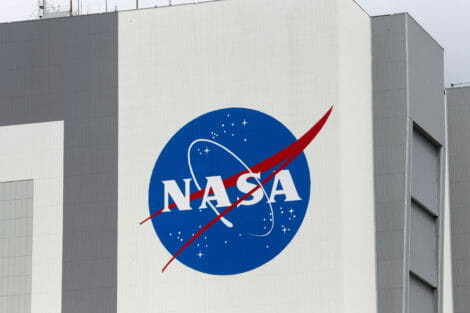NASA raises concerns about SpaceX satellite deployment plan

FILE PHOTO: The NASA logo is seen at Kennedy Space Center ahead of the NASA/SpaceX launch of a commercial crew mission to the International Space Station in Cape Canaveral, Florida, U.S., April 16, 2021. REUTERS/Joe Skipper
WASHINGTON — The National Aeronautics and Space Administration (NASA) has raised concerns about SpaceX’s plan to deploy about 30,000 satellites for its Starlink, as have some major companies.
Elon Musk’s SpaceX previously received authorization for about 12,000 satellites to offer broadband internet and has requested authorization for a second-generation constellation of 30,000 satellites.
“NASA has concerns with the potential for a significant increase in the frequency of conjunction events and possible impacts to NASA’s science and human spaceflight missions,” the agency wrote the Federal Communications Commission (FCC).
NASA noted there are currently 25,000 total objects tracked on-orbit – and about 6,100 below 600 km. SpaceX’s Gen2 expansion “would more than double the number of tracked objects in orbit and increase the number of objects below 600 km over five-fold,” it added.
Harvard-Smithsonian astrophysicist Jonathan McDowell, part of the American Astronomical Society panel examining the impacts of satellites on astronomy said: “We’ve been concerned with having these large numbers of satellites that interfere with astronomical observations… I think we need a little more experience with the several thousand operating satellites before we can ramp up to the tens of thousands.”
SpaceX did not immediately respond to a request for comment.
Musk tweeted on January 15 SpaceX had 1,469 Starlink satellites active and 272 moving to operational orbits soon.
Amazon.com, which has pledged to spend at least $10 billion to build 3,236 such satellites through its Project Kuiper program, separately raised concerns with the FCC about SpaceX’s plan as did Dish Network.
Amazon said under SpaceX’s application “at least hundreds—and potentially more than ten thousand—SpaceX satellites could operate at the same altitudes as the Kuiper System.”
It warned “the effect of this orbital overlap would be a dramatic increase in risks and other burdens on the Kuiper System” and asked the FCC to impose “reasonable conditions.”
While extremely costly to deploy, satellite technology can provide high-speed internet for people who live in rural or hard-to-serve places where fiber optic cables and cell towers do not reach. The technology could also be a critical backstop when hurricanes or other natural disasters disrupt communication.
RELATED STORIES
SpaceX rocket successfully launches US spy satellite
Elon Musk’s SpaceX links up with Filipino firms to bring Starlink services to PH
Starlink: Elon Musk’s latest scheme to offer Internet via satellites